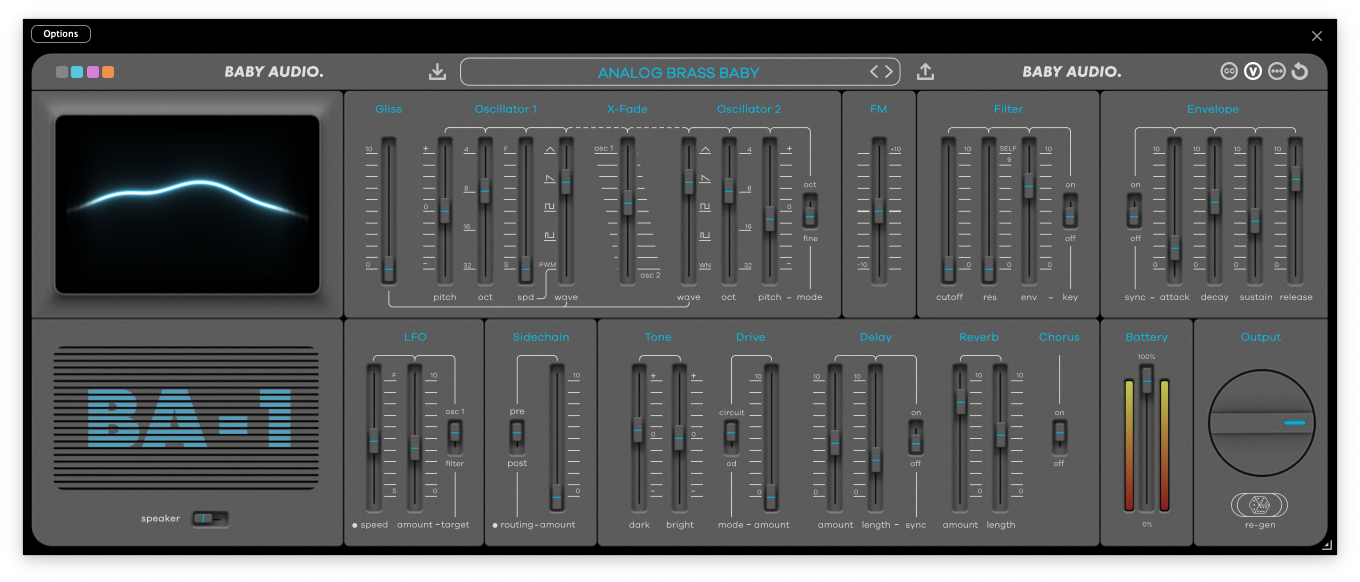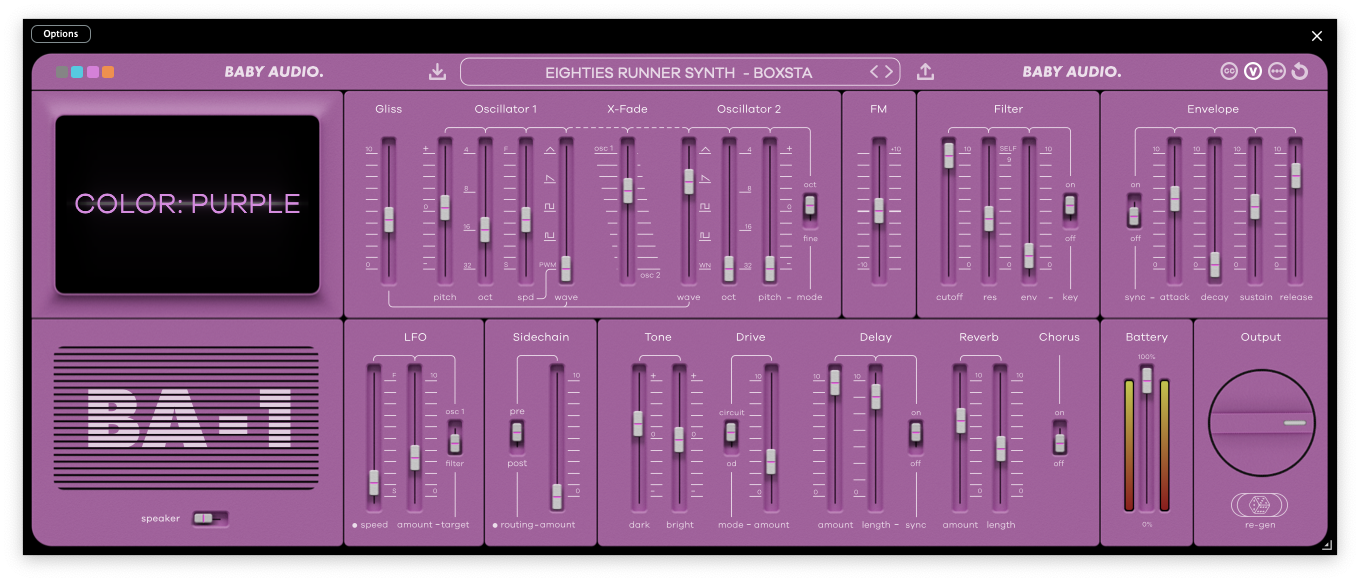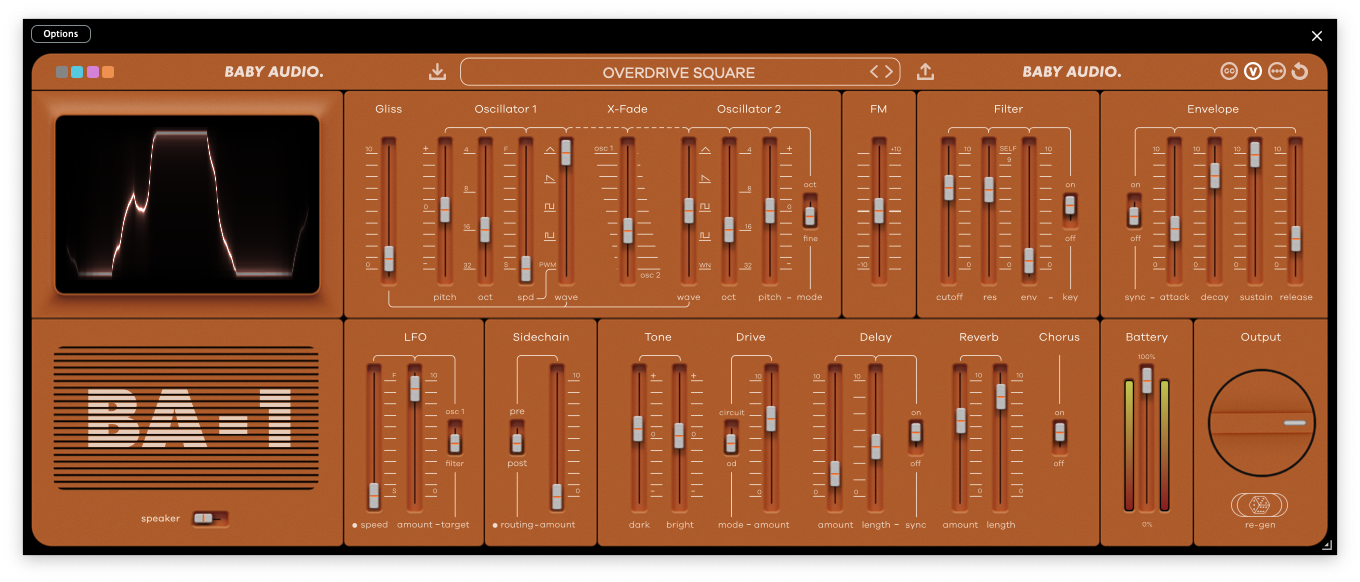BABY Audio BA-1 Review
- June 12, 2023
- by Steve Castellano
- Product Intelligence Report

Do you ever think about the word “play” as it applies to making music? That we play instruments, play back recordings, or play in a band? Maybe it’s just a random etymological coincidence. And for professional musicians, producers, and engineers, music isn’t always play – more often it’s hard work. But as a testament to the fun side of music, there are quite a few instruments that could easily be mistaken for playthings, or that even started out as literal toys – a child’s xylophone, the Speak & Spell, the Optigan, and some more obvious examples like the Casio VL-1. The clever folks at BABY Audio have recently revived one such gem in digital format with their newly-released BA-1 Analog Modelled Synth Plugin (VST/AU/AAX and standalone), and true to its toy-like inspiration, Yamaha’s battery-powered CS01 synth, it is fun not only to play, but also to play around with.
I never owned a CS01, but when I fire up the BA-1 I can almost feel it in my hands – particularly that plastic texture and contoured volume knob. The original, released in 1982, predated the Roland SH-101 by a year and didn’t capture the imagination of the music-producing public in quite the same way. This could be the result of the built-in speaker and mini-keys relegating it to the “toy” category, or the somewhat limited 12 db/octave filter (the Mk II, released in 1984, introduced a 24 db/octave filter, which is emulated in the BA-1). Even so, the real world version was musical enough to inspire the likes of artists as diverse as OMD and Chick Corea, and BABY Audio has added just enough fun new features to the BA-1 to elevate it to a surprisingly versatile instrument without losing the playful feel of the original. They’ve also added period-appropriate colour options, which not only add to the retro aesthetic but are also a great way to keep track of multiple instances in your DAW.

To Polyphony and Beyond
The CS01 was a somewhat limited instrument as synthesizers go. Notably, it had a single VCO and one envelope generator controlling both filter and amplifier. BABY Audio has wisely used the original hardware design as a jumping-off point for the creation of a much more powerful instrument rather than a strict feature-by-feature emulation. The two most significant improvements are the addition of a second oscillator, with the same triangle/saw/square/pulse/PWM waveform options as the original, in a clever mirror-image arrangement on the front panel. And, where the original instrument was monophonic, the BA-1 is polyphonic. These are two massive leaps in functionality, clearly, but the BA-1 still manages to preserve the fun and fizziness of the eighties original.
The filter section, for example, stays very much true to the Mk II hardware. It’s a 24 db low pass filter with resonance that can be pushed into self-oscillation, and which will in fact mute the oscillator input at its highest value. You still get just one envelope generator per voice, but you can now sync your EG attack time to your host DAW’s tempo, making the BA-1 fully rave-ready. Another dance-friendly addition is the sidechain input, which will duck the output of the BA-1 based on another track’s amplitude. There’s even a “fake” internal sidechain mode which simulates ducking to a four-on-the-floor kick.
In addition to a second oscillator, BABY Audio has introduced FM modulation to oscillator 1. You can dial (or rather slide) in audio rate modulation either an octave above or below the first oscillator for additional timbral variety. It’s not DX-style FM, so don’t expect electric pianos and doorbells, but rather what BABY Audio describes as “plasticky texture.”

A Bucket Brigade of Effects
BA-1 also includes the equivalent of a small pedal board’s worth of effects which were definitely not a part of the original CS01. These include Dark and Bright tone controls, a dual-mode Drive circuit, Delay and Reverb with period-appropriate graininess, and a one-setting Chorus (on or off) reminiscent of an effect found on certain polysynths of the era. And the lo-fi fun doesn’t stop there. You also get a Battery level slider, so you can emulate the particular distortion and pitch instability resulting from a dying battery (and keep it there for as long as you need to!), plus a speaker simulation switch – to instantly switch from a direct sound to that of the cheesy (but in a good way!) speaker of a portable keyboard.
The Playing’s the Thing
Of course the proof of any synth, real or virtual, is in the sound. And while you can certainly make the BA-1 sound like a plastic, portable mini-key synth if you want to, the dual VCO structure and polyphony option put it shoulder to shoulder with professional instruments that might have cost ten times as much as the CS01 back in 1982. The 500+ presets that it comes with cover a wide range of sounds, from lo-fi bloops and bleeps to room-shaking basses, squelchy leads and Prophet-style brass patches. I noted while paging through the vast selection that the Battery level seems to have captured the attention of many sound designers, and the warbly instability it introduces may end up being the keystone of the instrument’s signature sound.
And as an aid to sound design inspiration, BABY Audio has included a re-gen button, which generates new patches automatically. According to the manual, is it smarter than a mere randomizer, and designed to produce consistently musical results. The first time I hit the re-gen button (before I even knew exactly what it was) it spat out a surprisingly useful patch that was right up my alley. And thanks to the one control, one function interface of the synth, a screenshot is as good as a patch sheet, so here it is for your enjoyment if you want to dial it in.

Conclusions
The BA-1 promises fun and delivers. Its friendly, funky interface, complete with an oscilloscope window that doubles as a tool-tip display makes it inviting and easy to program, and the robust effects section makes it easy to dial up lush, moody or crunchy sounds as the mood strikes you. It’s not without its limitations of course. As a modular guy, I’m used to being able to patch anything into anything else, and that’s certainly not the aesthetic here. Even with that in mind, I wish I had the option to route the LFO to both VCOs simultaneously – currently the target is switchable between OSC 1 and Filter, which I thought was an odd design choice. But all things considered, BABY Audio has used a near-forgotten cult classic as the foundation for a powerful, quirky polysynth worthy of a starring role in your next synthwave masterpiece.
Latest Music Software ReviewsAuthor

Steve Castellano
Steve Castellano is a musician and writer living in Toronto, Canada. He holds a music degree from York University, where his focus was electronic music and composition. He currently records and performs modular electronic music under the name Elettronica Sperimentale.